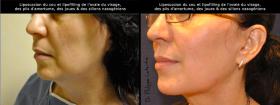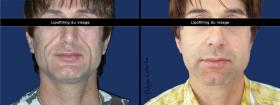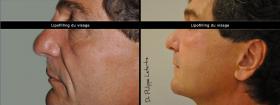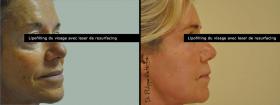A sculpted silhouette, a rejuvenated face lipofilling or Coleman’s lipostructure
What are the motivations for lipomodeling ?
Coleman’s lipostructure can be applied to many natural hollows, post traumatic or iatrogenic.
Some interventions thus belong to cosmetic surgery, and others to reparative or reconstructive surgery.
Indications in plastic surgery :
- Filling and attenuation of face wrinkles
- Restoration of "fullness" of a thinner and / or aged face
- In addition to cervico-facial facelift to improve facial harmony
Indications for repair and reconstructive surgery :
- The filling of a depressed tissue after a trauma
- The correction of secondary irregularities after liposuction
- The correction of fat wasting after triple therapy for HIV + patients
What are the objectives of cosmetic surgery ?
Take the fat where it is in excess and reinject it where it is missing. Volumes are restored, more harmonious. The skin quality is improved through the contribution of fat cells cleared out of their impurities.
This surgery has three advantages :
- It allows the harmonization of the volume, without foreign body
- It improves the quality of the skin in the injection zone
- It also treats excess fat localized disharmoniously in the sampling zone.
What happens during the surgery ?
The removal of fat is effected without trauma to the fat cells, with a very fine cannula. The fat collected is then processed by centrifugation, in order to get rid of impurities and thus collect a maximum of living cells, ideal candidates for transplantation.
Your purified fat cells are then reinjected using microcannulas on different levels and in several directions, by cutting about 1 mm.
In so far as this is a real living cell transplantation, the survival of adipocytes is therefore final.
+ What is the type of anesthesia ?
According to the case, anesthesia may be local, deep if administered intravenously by tranquilizers or general.
This will be the subject of a discussion between you and your surgeon during a consultation.
+ Where is located the microincision ?
The micro-incision is hidden in the natural folds of the sampling area.
+ And the scar ?
Resulting from the incision, it remains almost invisible.
+ How long is the surgery ?
It can vary from 30 minutes to 2 hours depending on the amount of fat to reinject and the number of zones to be treated.
What are the postoperative courses ?
The post-operative pain is generally minimal.
Bruising (bruises) and an edema (swelling) appear on the treated areas.
Physical recovery and resuming social activity are usually quick, you will adapt them to your pain.
The treated areas should not be exposed to UV for 4 weeks at least to prevent a skin pigmentation.
What is the expected result ?
Your volumes are restored, your hollows filled, your figure and your face have therefore gained in harmony. The result will begin to appear within 2 to 3 weeks after surgery but can definitely be appreciated after 3 to 6 months. Over time, the result will deteriorate gradually, due to the continued natural aging of these tissues.
What are the possible complications ?
Following any operation whatsoever , certain complications can occur, the first ones related to the medical activity and the others to anesthesia.
Although possible complications only represent a small percentage, it is necessary to know them.
+ What are the specific risks of anesthesia ?
During your obligatory talk with the anesthetist, he will inform you in detail of the risks of anesthesia.
It is useful to know besides that during the last twenty years, the risks have not been eradicated but remain almost insignificant.
+ What are the specific risks of the surgery ?
During the consultations with your surgeon all the possible complications will be detailed to you.
To inform you in advance, here are the possible risks :
- An infection which may require antibiotic treatment.
- A hyper-correction that may be related to the reinjection of an excessive quantity of fat and results in an excess volume that can be unsightly: in most cases, only reoperation with a real surgical removal of the excess fat will correct such hyper-correction.
These informations given by Dr. Philippe Letertre should only be a help or a supplement to your surgeon’s consultations
Our space "Questions / Answers" is also available for you.
Feel free to contact Dr. Letertre
so that he could meet your expectations.





